
Welcome to our Club of Amsterdam Journal.
“Humans have basically been the same anatomically for about 100,000 years – so what is safe to say is that if we enjoy it now, then so did our cave-dwelling ancestors and everyone else since, experts say.”
Old testament: “Abraham’s marriage was a crossover between polygamy and monogamy. He had servants and maidens, and at the same time would lead a monogamist conjugal life along with Sara. She was sterile and felt jealous towards the women who surrounded him and from who bore children, mostly those whose sons were of the male sex.”
“In a Roman household sex was in plentiful supply. Except, so it seems, between the actual married couples. The existence of slaves in the house naturally mean that, particularly the men, but also the women (although with the risk of pregnancy and disgrace), had access to sex whenever they so required.”
“The most difficult aspect of sex, widely acknowledged both by physicians and by priests, was its highly pleasurable nature, an aspect variously thought to indicate its inherently natural and/or sinful qualities. As a consequence of this duality, sex was most often depicted in extreme ways that ignored the well-balanced middle ground inhabited by most medieval people.”
“Many historians and psychologists see the late 1800s as a kind of watershed period for sexuality in the Western world. With the industrial revolution pushing more and more people together – literally – in dense, culturally-mixed neighborhoods, attitudes towards sex became more liberal.”
“The liberalization of sexuality kicked into high gear by the 1960s with the advent of the birth control pill, letting women get in on the fun and act on the basis of desire as men always had.”
From an informal 2005 global sex survey sponsored by the condom company Durex: “Just 3 percent of Americans polled called their sex lives “monotonous,” compared to a sizable 26 percent of Indian respondents. While 53 percent of Norwegians wanted more sex than they were having (a respectable 98 times per year, on average), 81 percent of the Portuguese were quite happy with their national quota of 108 times per year.”
Join our next Season Event and share your thoughts
the future of Sexuality – November 29, 18:30-21:15
Where: Waag Society, Nieuwmarkt 4, 1012 CR Amsterdam
Felix Bopp, editor-in-chief
Sex, The Internet’s Own Wasteland
 | by Melissa Gira, Editor, Sexerati.com, San Francisco |
The nymphs are departed.
And their friends, the loitering heirs of city directors;
Departed, have left no addresses.
– T. S. Eliot

I don’t mean to lay the blame at your feet, internet, but I am. How abysmal, how easy. In the morning there are sex bloggers on both America’s coasts (and in the middle, too, but there are fewer, or at least, fewer who say so) searching you for signs of intelligence, and just coming up pale and empty. For fuck’s sake, Technorati’s WTF? Sex has already been taken over with SEO rubbish, the fate of any social search tool that sex is allowed to traffic in (Yahoo killed theirs, and what of you, Mahalo?). Want to cry into your tea with less of a community of users driving your tears? Just customize your Google homepage to sex story feeds (here, I’m not territorial, are a few of mine: “sex study,” “sex research,” “sex science”) and read, weep, repeat. SEX NEWS IS BAD NEWS. Sex news tracked on the Web even more so. Sex news tracked by an untrained public? Just hand me my Hitachi and the handcrank generator, or something with enough batteries to get me off until the future arrives for real, please.
So what, then, would break through the internet wasteland of sex, where scandal passes for conversation and teaching people how to have an orgasm (so long as we don’t track your IP or tell your blogroll) and not get HIV is still seen as the apex of sex education? These are all still vital acts, yes, but they are not the whole picture of sex, not hardly. In fact, the more we focus on the endgame — coming, not dying — we lose the big picture, of why this information might be hard to come by in the first place.
What sex media would make a dent in this? Can sex media make a dent? Sex blogging at first seemed the answer: of course, people have been blogging sex since before blogging was blogging, and when blogging broke into genres — prematurely, I say, but of course, it brought advertisers with it — sex blogging itself went a bit stale. Is it good for the state of sex to just fill the web with more and more and more stories of all the ways we could, do, would fuck? Is it good for the state of sex to just say more — or ought we consider how to speak more smartly of sex?
Blogging is just a platform, blogging could be what we like, and FTW, Sexerati is not going to get all Andrew Keen on sex & the web, but what if it did? What if we dosed the sex web with a bit more erati – the gleeful elitism of sex that we supposedly dare not go there with? Sex is to be celebrated, sure, and people everywhere need better sex education, sex skill-building, sex comfort even.
But what else? Sex culture. Sex lit. Sex analysis. Sex theory. Sex happenings. Sex community.
Sex smarts, in other words, that fill the needs of not just the individual, but the sexual body politic. Sex that serves a civic duty, yes!
Sex that can be spoken from the rooftops and straight on through them, not just confined within a textfield.
There’s no argument that the internet has given rise to new sexual speech. Foucault, Sedgwick, Rubin, all would rejoice a little. Now, though, surrounded by new online sex acts each day, is it not time to apply a bit of a critical eye to how sexuality is produced by the internet? How we play a part in the production of sex in not just our reading, linking, and tagging, but in what we don’t even think to look for?
the piece is offered to you under a Creative Commons License
http://creativecommons.org/licenses/by-nc-nd/3.0/
Melissa Gira is a speaker at our event about
Next Event

the future of Sexuality
Thursday, November 29, 2007Registration: 18:30-19:00, Conference: 19:00-21:15
Make your reservation and book online Ticket Corner
Where: Waag Society, Nieuwmarkt 4, 1012 CR Amsterdam [Center of the Nieuwmarkt]The conference language is English.
The speakers are
Marie-Louise Janssen, Lecturer, Department of political science, Gender Studies, University of Amsterdam
Paid Sex and Public Space
Melissa Gira, Editor, Sexerati.com, San Francisco
“The Story of i”: Sex in the Information Age
Luc Sala
Sexuality: the back door into our essence
Moderated by Mirjam Schieveld, Head of the Summer Institute, International School for Humanities and Social Sciences
Supporter: Waag Society
Club of Amsterdam blog
News about the Future

Microbial Fuel Cells Produce Hydrogen from Waste Water
Professor Bruce Logan introduces the „BioElectrochemically-Assisted Microbial Reactor“ (BEAMR).
Microbial fuel cells (MFCs) represent a completely new method of renewable energy recovery: the direct conversion of organic matter (e.g. sewage waste) to electricity using bacteria.
A Penn State research group headed by Dr. Bruce Logan is working on developing MFCs that can generate electricity while accomplishing wastewater treatment.
Bacteria that feed on vinegar and waste water zapped with a shot of electricity could produce a clean hydrogen fuel to power vehicles that now run on petroleum. These microbial fuel cells can turn almost any biodegradable organic material into zero-emission hydrogen gas fuel.

Organic TVs
OLEDs are a flat display technology, made by placing a series of organic thin films between two conductors. When electrical current is applied, a bright light is emitted.
OLEDs have the following advantages over today’s LCD or plasma displays:
- Exciting displays – new types of displays, that we do not have today, like ultra-thin, flexible or transparent displays.
- Low power consumption – OLEDs are a far better choice for portable devices. It also makes OLEDs much more environmental friendly, and a candidate to be the white-light “bulb” of the future
- Greater brightness – The screens are brighter, and have a fuller viewing angle.
- Better durability – OLEDs are very durable and can operate in a broader temperature range
- Lighter weight – the screen can be made very thin, and can even be ‘printed’ on flexible surfaces
Sony will start selling OLED TVs in December 2007. But these will be small and pricey. The main issue is the lifetime – OLED displays degrade after a certain time – and also production cost are still high. Theoretically OLEDs may become cheaper than LCD.
Samsung has published their OLED roadmap for the coming years. In 2008 they want to have 3.5 to 7 inch displays – for ultra-mobile PCs or PDAs. In 2009 they will have 14″-21″ panels, to be used in laptops and desktop monitors. In 2010 they expect to commercialize 40″/42″, Full HD OLED TVs.
The Future of Human Evolution
 | by Chris Thomson, School of Consciousness |
Although there is much said and written about the history of human evolution, very little is said and written about the future of human evolution. Nearly all discussion about the future is about the future of technology, the future of society, and the future of the planet (climate change, resources etc). There is almost no discussion about the future of the human being as such. Perhaps this is because there is a widespread, if unstated, assumption that, in evolutionary terms, we have come about as far as we are going to go, and that all that remains for us to do is to find ways of solving our seemingly intractable problems and otherwise living fulfilling lives.
I take a very different view. Although I agree that it has become a matter of critical urgency that we find ways to solve the many problems that we have created for ourselves (and for the rest of nature), I also believe that we are very unlikely to be able to do this until we give high priority to the development of ourselves as human beings. Clearly, this needs some explanation, particularly when it is widely believed that all we have to do to solve our problems is change the behaviours that seem to be causing them. While it is obviously true that changing our behaviours would make a big difference – to climate change, crime, war, illness and poverty, to name just a few – I do not think that this will be sufficient in itself, nor do I think that it will be sustainable in the long run. Unless and until we change ourselves at a very deep level, changes at a superficial level (i.e. behavioural) are likely to be only temporary. The likelihood is that we will eventually revert to problem-causing behaviours simply because the deeper psychological, cultural and spiritual causes of these behaviours will have gone unrecognised and unaddressed. That said, I am by no means suggesting that we ignore the need for behavioural change. They are clearly much better than doing nothing, some of them may turn out to be relatively permanent, and at least they buy us much needed time while we turn our attention and energy to the deeper root causes of our problems.
I do not wish to say much about why we are in such a mess – I prefer to focus on the way forward – but I would like to lay out the proposition that, for a host of reasons, we have, over the millennia, allowed parts of the human being to evolve at the expense of the other parts. When I contemplate the future of human evolution, I see it mainly as the evolution of important parts of ourselves that we have neglected or denied for so long. To express this as simply as possible, we have allowed the physical/material parts of the human being to evolve at the expense of the non-physical/spiritual parts. This has had immense consequences. At the social and cultural levels, we live in an age of rampant materialism where material (and economic and financial) values take precedence over all others. And at the level of exploration and understanding, our dominant knowledge system, science, focuses almost exclusively on the physical. It is no exaggeration to say that, for most people, including most scientists (I assume), the universe and everything in it, ourselves included, is entirely physical in nature. Any experience or phenomenon that appears to contradict this should be ignored, denied or explained away.
That this is causing metaphysical confusion, to say the least, is evident in the kinds of discussion typified by Richard Dawkins and “The God Delusion”. It is a sterile discussion because it will go nowhere until Mr Dawkins and the many who share his views recognise that it is possible, and desirable, to have a very different experience of the world. That materialism is causing many of the world’s problems, including crime, war, much illness, much poverty, not to mention climate change and other damage to the biosphere, is obvious to all with eyes to see.
The challenge – and it is a very big challenge – is that the only reality for the majority of people today is the physical/material reality. That is not entirely true, for many people report having “extraordinary” experiences, but there is nowhere in modern culture to place these experiences, so they tend to get put to one side and eventually ignored. I believe that the current situation – the prevalence of materialism and the prevalence of a physical/material worldview in science – will change only when we change, in other words only when we evolve as we are capable of evolving. We need to move on to the next major stage of human evolution. Clearly I cannot be certain about this, but I have a very strong sense that the time has come to awaken and develop parts of ourselves that we have ignored and denied for far too long – in essence, the non-physical/spiritual parts. The big difference, I believe, on this occasion is that this will be conscious evolution, in the sense that we will know what we are doing and why we are doing it. We shall be doing it for at least three good reasons: to get beyond materialism; to open science up so that it becomes science of the whole, as distinct from science of the (physical) part; and to show ourselves, in very tangible ways, who we really are and what we are capable of becoming.
Recommended Book

Handbook of the Evolution of Human Sexuality
by Michael R. Kauth
Humans are inherently sexual creatures, and human culture is essentially a sexual culture. This edited volume helps to explain “why” humans are so consumed with sexuality.
The volume’s primary theme is the evolution of human sexual attraction: that is, evolved human sexual psychologies. Scholars from a variety of fields, including anthropology, primatology, psychology, and biochemistry, discuss human (hetero)sexual attraction, mating/reproductive strategies, and mate preferences from the perspective of Evolutionary Psychology. Three authors also present theories of same-sex sexual attraction.
A secondary theme is the explication of sexual concepts and implicit assumptions about sexuality. Scientists and scholars in the multidisciplinary field of sexology often employ common but imprecise concepts that are loaded with personal and discipline-specific assumptions that are rarely acknowledged and even more rarely discussed. In this volume, contributors attempt to define specific sexual concepts and discuss their assumptions about sexuality. The volume concludes with an analysis of how contributors used sexual language and their avoidance of the concept of “sexual orientation”.
The Oceans of the Future
Vision for the Future
The future of the people of the Earth and the future of the World Ocean are tightly connected. The tendency for humans to use and control the Ocean is explained by the enormous potential of its resources. The Ocean should contribute to feeding the increasing World population, and satisfy the needs of the energy and raw materials industries which are presently being depleted on land. The Ocean is the cradle of life on our planet. It should remain that way, with an environment favourable to the replenishment of life. The only scientifically-justified strategy for using the Ocean environment wisely is to guarantee its rational use, balanced with the protection of the unique marine communities. The foundation for “Oceans of the Future” is Man and the Ocean, a CD-ROM produced by the Russian Head Department of Navigation and Oceanography (HDNO).
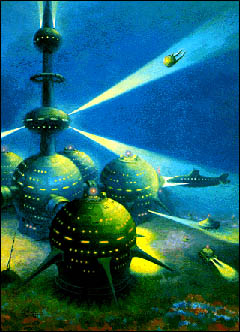
Present Construction & Designs for the Future
Future use of the resources of the Ocean and development of commercial relations requires the expansion of construction projects . Ancient Man could only rely on practical knowledge and simple tools. However, modern nautical architectural science and practice rests on an already-developed theoretical base with models showing the natural movement of waters and an extensive network of observations on the land and sea. These observational data are widely used for designing construction projects of commercial structures on the Ocean.
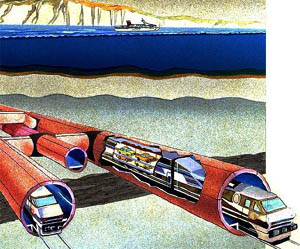
Bold Projects for the Future
The World Ocean – the present storehouse of raw materials and energy, is the acknowledged source for the future of Mankind. The progress made in science and engineering has pushed aside obstacles and barriers for forward thinking and commercial development of maritime projects. The acute shortage of land in many countries, the complexity of entering and leaving existing waterways to a majority of ports, the increasing tendency towards the use of resources of the World Ocean and the strengthening of requirements in the battle against pollution of the environment – all of these factors have brought new life and meaning to ideas for the construction of new ports, industrial facilities, anchorage zones, etc. on artificial islands.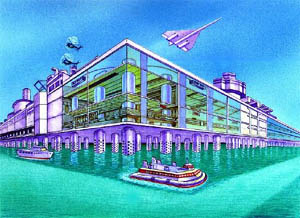
There are many architectural designs for ocean cities. The “Ocean Venice” project deserves special attention. An artificial island holding up to 30,000 people, would be erected 28 km from the east coast of Great Britain, over a depth of 10 m of water. The city, shown here in an artist’s concept, appears to have a step-like wall, similar to that of a huge amphitheatre. Power stations, fuelled by locally-supplied underwater natural gas, would be located on the perimeter. This artificial island would be built on a concrete and rock base. The wall of the amphitheatre would serve to protect the city from winds, and the upper, circular tiers will be used for living accommodations, joined together by escalators.
As the depth to the sea floor increases, the cost of fixed, artificial islands sharply increases. Therefore, a great deal of interest has been shown in the concept of “floating islands”. Building islands that float is a widely used practice. In the port city of Valdez, Alaska, a floating container terminal has been built, consisting of two sections which are anchored, and are connected to the shore by two steel bridges.
Floating islands will be constructed from concrete and steel designs, which are intended for accommodating factories or shipyards. To keep them in place, there will be anchor pilings, or supports fixed to the sea bed. Along Arctic coastlines, artificial areas could be created by using islands formed by pack ice.
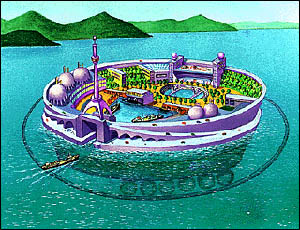
The floating city project – an industrial complex for extracting and shipping mineral wealth from the sea floor
Industrial complexes built on the sea floor will need a maintenance base on the Ocean surface. It will represent a floating city, the body of which is constructed from steel or steel and concrete. In this city – base, it will be necessary to install a high-power electrical facility, repair plant, shops, storage, and other buildings needed to service an underwater industrial business, and to maintain the normal life of the people living there. From the city – base there will have to be transport vessel moorings, ensuring access to the shore. Even storms will not be disruptive for such a city, because their effects will be greatly dampened by a pneumatic breakwater made from plastic pipe with sets of holes. The breakwater pipe will surround the entire city area, incorporating a compressor station. If there are small waves on the sea, the breakwater does not operate, but as soon as the size of the waves become menacing, automatic control units will activate the compressors.
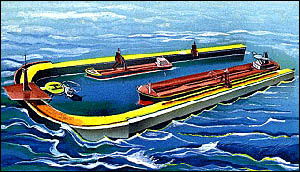
A floating-port project built of steel and reinforced concrete
The floating island can be a marine port which will ensure safe mooring of large-tonnage vessels. Cargo vessels and tankers can deliver minerals and petroleum extracted from the sea floor in such ports. Engineers have produced a huge horseshoe design for this type of floating facility, with protected spaces inside, serving as a port of call for these vessels.
There are already artificial ports with well-arranged terminals for cargo handling situated at significant distances from the shore.
Fishing by underwater trawlers
Underwater oil tanker of the future
A recreation facility built in Australia
Cruise liner of the 21st century
The floating airport of future
Household Robots
By the end of 2007, 4.1 million robots will be doing jobs in homes, says the report by the UN Economic Commission for Europe and the International Federation of Robotics.As well as the vacuuming, they will take over tasks like mowing the lawn, cleaning pools, and washing windows.
Service robots for personal and private use: about 2.44 million units for domestic
use and about 1.1million units for entertainment and leisure sold up to end 2005
Service robots for personal and domestic use are recorded separately, as their unit value is only a fraction of that of many types of service robots for professional use. They are also produced for a mass market with completely different marketing channels.
So far, service robots for personal and domestic use are mainly in the areas of domestic
(household) robots, which include vacuum cleaning and lawn-mowing robots, and entertainment and leisure robots, including toy robots, hobby systems and education and training robots.
The market for robots for handicap assistance is still small, but is expected to double in the next four years. Robots for personal transportation and home security and surveillance robots will also increase in importance in the future.
Up to the end of 2006, accumulated sales of vacuum cleaning robots resulted in 2.35 million units. At the end of 2006, the stock of lawn mowing robots amounted to 91,000 units.
It is projected that sales of all types of domestic robots (vacuum cleaning, lawn-mowing, window cleaning and other types) in the period 2007-2010 could reach some 1.34 million units.

Yujin Robotics of Korea introduces the nanny robot. The iRobi, is described as an internet-based family robot. iRobi can take and edit photos, combine nursery rhymes with robot dances, provide fairy tale-based tutoring and even accept your custom programming.

Scooba, the floor-scrubbing robot from iRobot. These smart, efficient robots prep, wash, scrub and squeegee tile, linoleum and sealed hardwood floors so you don’t have to! Scooba navigates throughout each room and uses a 4-stage cleaning system to prep, wash, scrub and squeegee sealed hardwood, tile and linoleum floors.

The PaPeRo from
NEC Personal Robot Research Center has been researched and developed with the intention of its being a partner with human beings and its being able to live together with them.For this reason, it has various basic functions for the purpose of interacting with people: Face detection, facial identification, face tracking and condition detection feedback. It has a vocabulary of about 550 words. It can also connect to the Internet, so if you ask it what the weather is going to be, it will link up to a weather site and report its findings.
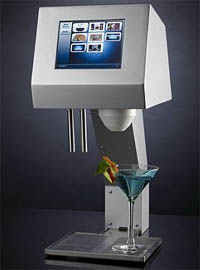
MyFountain from digital beverages is a stainless steel, robo-bartender that can serve you hot, cold, carbonated, alcoholic and non-alcoholic beverages like sodas, juices, vitamin enhanced water, beer, liquor, mixed drink cocktails, and even wines. It allows you to personalize your drink and create your own, personal beverages. It knows exactly what you like because you program it specifically to your tastes. If you don’t know what to make, there is even an online drink recipe generator that will help you out.
ConnectR from iRobotis a mobile webcam with microphone, speakers and headlight. The device has been designed for busy parents and distant grandparents seeking greater connection with their kids, grandkids and pets.
Agenda

| The Season Events are on Thursdays Registration: 18:30-19:00, Conference: 19:00-21:15 | ||
| November 29 18:30 – 21:15 | the future of Sexuality Location: Waag Society, Nieuwmarkt 4, 1012 CR Amsterdam [Center of Nieuwmarkt] | |
| January 31 18:30 – 21:15 | the future of Fashion Location: | |
| February 28 18:30 – 21:15 | the future of NanoEnergy Location: | |
| March 27 18:30 – 21:15 | the future of Ecological Architecture Location: Rotterdam | |
| April 24 18:30 – 21:15 | the future of Money Location: | |
| May 29 18:30 – 21:15 | the future of Children Location: Info.nl, Sint Antoniesbreestraat 16, 1011 HB Amsterdam [Next to Nieuwmarkt] | |
| June 26 18:30 – | Taste of Diversity – the future of INDIA |
Club of Amsterdam Open Business Club
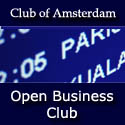 | Club of Amsterdam Open Business Club Are you interested in networking, sharing visions, ideas about your future, the future of your industry, society, discussing issues, which are relevant for yourself as well as for the ‘global’ community? The future starts now – join our online platform … |




Customer Reviews
Thanks for submitting your comment!